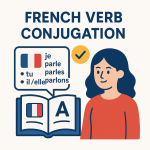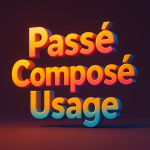
Mastering Compound Tenses: A Deep Dive into Advanced French Verb Conjugation
June 12, 2025
Passé composé usage
June 12, 2025In the realm of French language acquisition, present tense conjugation serves as a foundational cornerstone. However, the interplay between irregular verbs and the subtle nuances of aspectual meanings remain underexplored. Understanding these advanced mechanisms is crucial for teachers, parents, and students as it directly influences linguistic proficiency and comprehension. This aligns perfectly with LearnFrenchTutor (LFT)’s mission of being a Quick French Tutor for French Students, providing tailored guidance for achieving mastery in French.
The Importance of Irregular Verbs
Irregular verbs in French occupy a unique position in present tense conjugation. Unlike regular verbs that follow predictable patterns, irregular verbs require learners to employ memorization and contextual understanding to use them accurately.
- There are approximately 300 common irregular verbs in French, with around 60 frequently used in everyday conversation.
- Focusing on the top 10 irregular verbs can significantly boost conversational skills and comprehension.
- Mastering irregular verbs helps students navigate complex sentences and idiomatic expressions.
Aspectual Nuances: The Subtleties of Present Tense
The concept of aspect in the French present tense can vary significantly, conveying meanings beyond mere action occurrence. Students should recognize aspects like habitual actions, ongoing processes, and punctuated actions.
- The present tense can express both ongoing actions using ‘être en train de’ and habitual actions.
- Students can differentiate between ‘je mange’ (I eat) and ‘je suis en train de manger’ (I am eating) to convey time variations effectively.
- A deep understanding of aspects can enhance narrative skills within stories or descriptions.
Techniques for Teaching Present Tense Conjugation
Effective pedagogical strategies can aid learners in grasping the complexities of present tense conjugation, making the conjugation process less intimidating.
- Incorporating games and interactive apps can foster a playful learning environment while practicing conjugations.
- Utilizing song lyrics to identify and practice irregular verbs builds a cultural connection, enhancing retention.
- Creating conjugation charts that visually represent transformations clarifies conjugation patterns for visual learners.
Real-Life Applications of Present Tense in French
Embedding present tense conjugation in real-life contexts makes learning applicable and relatable. An understanding of its usage in conversations, emails, and informal dialogue boosts students’ confidence.
- Students can practice by writing personal journals or letters in French to reinforce present tense usage naturally.
- Role-plays in everyday scenarios encourage students to think on their feet and apply their knowledge dynamically.
- Engaging with native speakers develops fluency and showcases practical usage of tenses.
Data-Driven Insights on Learning Present Tense Conjugation
Research indicates that integrating technology into language learning not only enhances retention but also overall comprehension rates. Utilizing data-driven methods can optimize learning experiences.
- Studies show that learners who engage with digital flashcards demonstrate a 50% increase in recall compared to traditional methods.
- Gamified learning increases engagement rates by 70%, improving motivation for challenging concepts like present tense conjugation.
- Personalized learning journeys tailored to individual needs can lead to faster and deeper mastery of conjugation skills.
Mastering the nuances of present tense conjugation is pivotal for achieving fluency in French. By focusing on irregular verbs, aspectual meanings, and implementing data-driven teaching techniques, students can cultivate a robust understanding of this essential skill. Join LearnFrenchTutor (LFT)—your Quick French Tutor for French Students—to access expert strategies and personalized guidance, ensuring your journey to French fluency is as smooth as possible.

